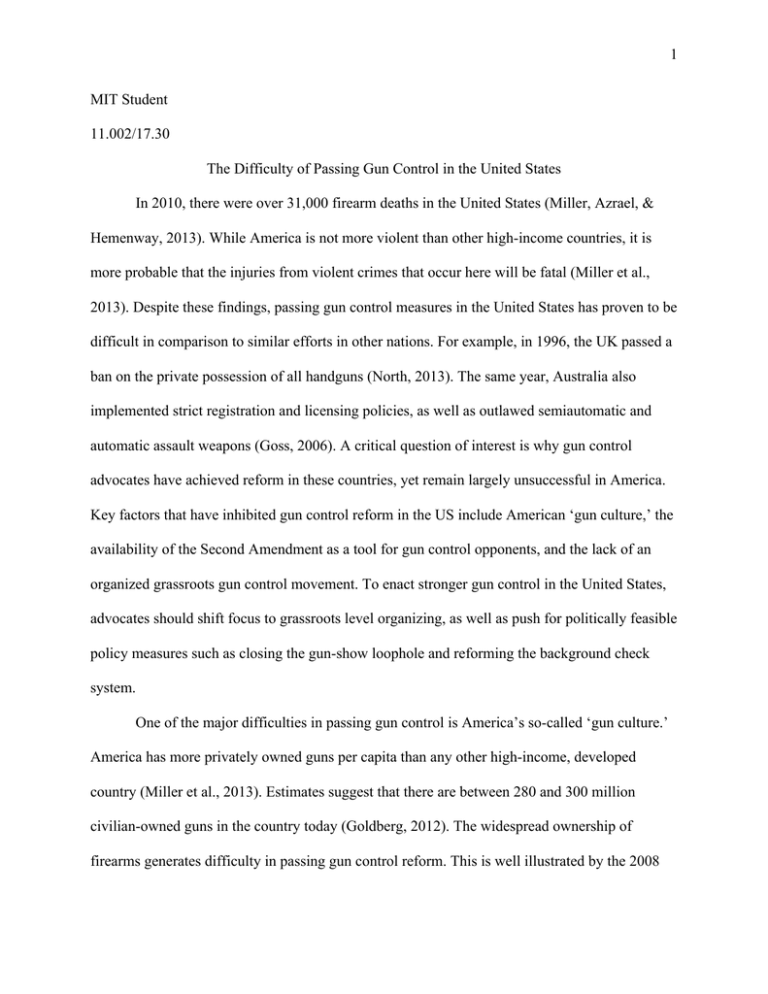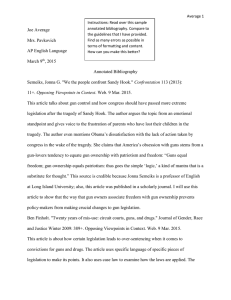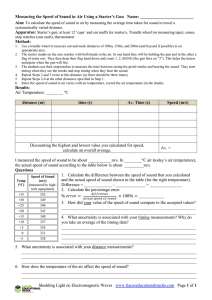1 MIT Student 11.002/17.30
advertisement

1 MIT Student 11.002/17.30 The Difficulty of Passing Gun Control in the United States In 2010, there were over 31,000 firearm deaths in the United States (Miller, Azrael, & Hemenway, 2013). While America is not more violent than other high-income countries, it is more probable that the injuries from violent crimes that occur here will be fatal (Miller et al., 2013). Despite these findings, passing gun control measures in the United States has proven to be difficult in comparison to similar efforts in other nations. For example, in 1996, the UK passed a ban on the private possession of all handguns (North, 2013). The same year, Australia also implemented strict registration and licensing policies, as well as outlawed semiautomatic and automatic assault weapons (Goss, 2006). A critical question of interest is why gun control advocates have achieved reform in these countries, yet remain largely unsuccessful in America. Key factors that have inhibited gun control reform in the US include American ‘gun culture,’ the availability of the Second Amendment as a tool for gun control opponents, and the lack of an organized grassroots gun control movement. To enact stronger gun control in the United States, advocates should shift focus to grassroots level organizing, as well as push for politically feasible policy measures such as closing the gun-show loophole and reforming the background check system. One of the major difficulties in passing gun control is America’s so-called ‘gun culture.’ America has more privately owned guns per capita than any other high-income, developed country (Miller et al., 2013). Estimates suggest that there are between 280 and 300 million civilian-owned guns in the country today (Goldberg, 2012). The widespread ownership of firearms generates difficulty in passing gun control reform. This is well illustrated by the 2008 2 Supreme Court case Columbia v. Heller. In this case, the justices ruled that a Washington DC ban on handguns was illegal, because handguns were “the most popular weapon chosen by Americans for self-defense” (Toobin, 2012). This case demonstrates that popularity of guns is sufficient justification for striking down gun control legislation. To an extent, this is about feasibility. According to Goldberg (2012), “America’s level of gun ownership means that even if the Supreme Court…suddenly reversed itself and ruled that the individual ownership of handguns was illegal, there would be no practical way for a democratic country to locate and seize those guns.” Thus, America’s high levels of gun ownership make it hard to pass restrictive reform. This American gun culture differs from the cultural climate in the United Kingdom and Australia. Prior to the major gun control reform in the UK, increasing rates of handgun crime spurred anxiety over the possibility of “an ‘American-style’ gun culture taking hold” (North, 2013). Additionally, Great Britain has low levels of gun ownership, unlike America. While debates over gun control in the US include the idea that more legally held guns may help lower violent crime (VerBruggen, 2010), the dominant belief in the UK was that “guns were part of the problem, not part of the solution” (North, 2013). In contrast to the UK, Australia has an established gun culture. Unlike American culture, however, people use guns in Australia primarily for sport, hunting, and farm use, and not self-defense (Peters, 2013). These differences in culture, including levels of and primary reasons for gun ownership, explain in part why gun control reform has been more difficult to pass in America. In addition to the broad issue of pervasive gun culture in the US, the Constitution presents a specific barrier to reform. The Second Amendment states the following: “A wellregulated militia being necessary to the security of a free State, the right of the people to keep 3 and bear arms shall not be infringed.” Despite the fact that its current popular interpretation confers citizens the “right to bear arms,” its meaning has not been static over time. For over a century, Americans believed the Second Amendment guaranteed a right to bear arms for state militia, rather than for individual citizens (Toobin, 2012). It was not until the 1970s, when the National Rifle Association (NRA) gained a lobbying arm, that the interpretation shifted to its current meaning (Lepore, 2012). Toobin (2012) describes this process of re-interpretation as “an elaborate and brilliantly executed political operation.” By using rhetoric that portrays gun control as antithetical to our constitutionally given rights, the NRA’s newer interpretation of the Second Amendment shifted the gun control debate in favor of gun rights activists. In contrast, the concept of a “right to bear arms” is relatively non-existent in the UK. In the UK, law permits private ownership of guns only when the owner has an “appropriate reason,” which excludes self-defense (North, 2013). In general, the gun control debate there “was not clouded by arguments over self-defense and the right to bear arms” (North, 2013). This difference in ideology about gun rights is a key reason why gun control reform has been less successful in the United States than in Great Britain. The Second Amendment does not fully explain the difficulty in passing gun control measures in America. After all, public opinion polls indicate that between 70 and 80% of Americans would support a law requiring permits for gun ownership (Goss, 2006). Yet, gun control advocacy group membership is only about 7% of the NRA’s (Goss, 2006). This constitutes what Goss dubs the “gun control participation paradox.” In other words, despite the majority of the public favoring stricter gun control, the amount of active participation in gun control efforts is minimal. In fact, elites, not grassroots movements, champion most gun control reform in the US (Goss, 2006). This is different from gun control efforts in the UK, where 4 campaigns “ran on limited budgets…relying mostly on the efforts of volunteers…and never came to depend on large organizations or high-profile celebrities” (North, 2013). Likewise, it is dissimilar to Australia, where a strong grassroots movement emerged from a diverse range of interest groups including public health societies, women’s groups, and the police. This demonstrated that gun control in Australia was a mainstream concern as opposed to an interest specific to a single-issue group (Peters, 2013). The elite-driven agenda in the United States has simply failed to mobilize the pro-gun control majority in the way grassroots movements in the UK and Australia have done. Given these barriers to reform, there are certain recommendations I would give to gun control advocates who wish to enact stronger gun control in the US. From a political standpoint, gun control reform efforts should move away from an elite-focused advocacy system to one that builds up the strength of grassroots movements. Currently, legislators and elite interest groups are the primary proponents of gun control reform. Additionally, gun control advocates frame issues in a way that is inaccessible and not targeted to the general public (Goss, 2006). If gun control advocates wish to mobilize the ‘silent majority’ of people who support stricter gun control, they should use strategies and rhetoric that appeal to everyday people as opposed to just policy experts. Then, with an engaged public, reform will be more likely to pass. When it comes to policy, the primary focus should be on modest measures for gun control. One straightforward step is legislation to close the gun-show loophole. Currently, people who wish to purchase a gun from a licensed dealer need to obtain a permit and go through safety training. However, 40% of firearms are purchased through private sellers at gun shows, and the people buying these guns do not have to go through this process (Lepore, 2012). Requiring all sales to be conducted through licensed dealers should not infringe on the “right to 5 bear arms” that the Second Amendment has come to represent. Therefore, this measure should generate less opposition than stricter proposals. Other potentially feasible policy measures are reforms of the background check system. Useful measures could include extending the period of time the FBI has to perform the checks, expanding the types of risks background checks should account for (e.g. violent misdemeanors and restraining order violations), and requiring government agencies to submit all their data on gun violence to the national background-check database (Gopnik, 2013). Closing the gun-show loophole and enhancing the background check system are both modest policy measures that should garner majority support, generate minimal opposition, and help propel gun control efforts forward. American gun culture, the strategic use of the Second Amendment by gun rights proponents, and the “non-movement” of gun control advocates all pose significant barriers to gun control reform in the US. Gun control advocates should therefore work on fostering a grassroots movement to mobilize the pro-gun control majority, as well as push for modest reforms such as closing the gun control loophole and reforming the background check system. With these political and policy recommendations in mind, advocates should be able to overcome some of the barriers that have inhibited gun control reform efforts in America that are less present in the UK and Australia. 6 Works Cited Goldberg, Jeffrey. “The Case for More Guns (And More Gun Control).” Atlantic Monthly, 2012. Gopnik, Adam. “A Few Simple Ideas about Gun Control.” The New Yorker, 2013. Goss, Kristin A. “Chapter 1.” In Disarmed: The Missing Movement for Gun Control in America. Princeton: Princeton University Press, 2006. Lepore, Jill. “Battleground America.” The New Yorker, 2012. Miller, Michal, Deborah Azrael & David Hemenway. “Firearms and Violent Death in the United States.” In Reducing Gun Violence in America. Baltimore: The Johns Hopkins University Press, 2013. North, Michael J. “Gun Control in Great Britain after the Dunblane Shootings.” In Reducing Gun Violence in America. Baltimore: The Johns Hopkins University Press, 2013. Peters, Rebecca. “Rational Firearm Regulation: Evidence-based Gun Laws in Australia.” In Reducing Gun Violence in America. Baltimore: The Johns Hopkins University Press, 2013. Toobin, Jeffrey. “So you think you know the second amendment?” The New Yorker, 2012. VerBruggen, Robert. “More Handguns, Less Crime—or More?” American Spectator, 2010. MIT OpenCourseWare http://ocw.mit.edu 11.002J / 17.30J Making Public Policy Fall 2014 For information about citing these materials or our Terms of Use, visit: http://ocw.mit.edu/terms.






